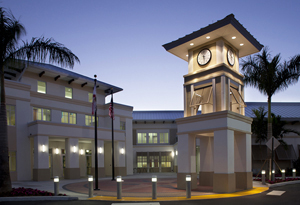By Ray Burow
Wellington’s Equestrian Preserve Committee granted a series of approvals last week that would allow the development of Flying Cow Ranch, a 30-lot equestrian/aviation project on the western edge of the community.
Flying Cow Ranch is located approximately four miles south of Southern Blvd. at the northwest corner of Flying Cow Ranch Road and 160th Trail South. If approved, the project would allow for equestrian and aviation use on each of the proposed lots in the approximately 150-acre development.
The plan was approved, with conditions, by committee members at the Oct. 4 meeting.
“What has been presented here certainly gives us an opportunity to make Wellington that [world class] place, where you can own your two acres or three acres — heck, I guess you can buy four acres — and have a nice place to fly in and to fly out,” Committee Member Dr. Sergio Guerreiro said.
At the meeting, the committee heard four items related to Flying Cow Ranch, including a comprehensive plan change amending the future land use map, zoning text amendments, a rezoning and a master plan approval.
The committee heard a presentation for amending the future land use map designation of the parcel and to extend Wellington’s Equestrian Preserve Area boundaries to incorporate the area. This would include adding additional trails and paths to Wellington’s equestrian trail system.
Within the zoning text amendment proposal, an area labeled Subarea G would be created, establishing development regulations, along with regulations for the landing strip, taxiway and hangars. Hangars would only be allowed as accessory structures and will be consistent with the same style of the residence, and no structures will be allowed within 50 feet of the runway.
Some committee members had questions concerning the maximum density per acre. The plan overall allows an average of 0.2 dwelling units per acre, and the minimum lot size is two acres.
“Since they’re such small lots comparing to some of the other equestrian areas, where they have extremely small lots, is there going to be a limitation on the number of horses per acre and the number of stalls per acre, or was that not discussed?” Vice Chair Dr. Kristy Lund asked.
Wellington Senior Associate Planner Damian Newell assured Lund that proper regulations on the number of horses will be put in place.
“It’s all limited to the square footage of the overall stable, which, based on the lot size, will determine how many stalls you could have,” Newell said.
The property is currently broken into three different parcels with different zoning map designations. The rezoning petition would change the entire property to Planned Unit Development/Equestrian Overlay Zoning District.
The Flying Cow Ranch Master Plan includes 30 residential lots which can incorporate both equestrian and aviation uses. A clubhouse, maintenance facility, private trail/path and common recreational area, guardhouse entrance, airplane tie-down/fueling area, 18 acres of lakes and a private airstrip are all parts of the amenities that will be offered.
The landing strip will be extended from the current length of 1,800 feet to 4,891 feet. The additional length to the existing airstrip will require an amendment to the current airport registration and will have to be approved by the Federal Aviation Administration and the Florida Department of Transportation.
Jennifer Vail, agent for the applicant, reiterated the plan for the committee and also provided a brief review of the history of amendments affecting the Flying Cow Ranch property. Vail also said that there are other communities around the country with a similar equestrian/aviation design.
However, some committee members were concerned with mixing horses and airplanes in close proximity.
“I couldn’t fathom, as an equestrian, to have the horses and the airplanes mixed together,” Lund said. “I couldn’t find a single example of where they were together in the examples you provided.”
Vail said the proximity is not that different than with Wellington’s existing aviation community, the Aero Club, which is fairly close to equestrian areas.
“We actually did find some other examples where the airplanes were going right over top the horses. We did not provide all of those examples. I believe it was in the Ocala area,” Vail said. “But we had discussions with staff about the compatibility and the concern of equestrians. We don’t feel that the amount of airflow traffic that would be coming through is going to be any greater than what you have at the Aero Club, which is so close to some of the other existing equestrian properties.”
Committee Member Dr. Rachel Eidelman asked Vail to elaborate on whether the proposed clubhouse would be open to the public.
“It is private and part of the PUD, so it is only for the residents of the PUD.” Vail said.
Resident Houston Miegs brought two concerns before the committee: the speed of traffic on Flying Cow Ranch Road and the number of roads that could possibly be paved in the future, resulting in more through-traffic.
On the committee’s concern about the number of stalls per acre, it was agreed that the applicant would place a limit on the number, which would be noted in the zoning text amendment and would be a condition of the master plan.
The committee passed the four proposals 5-0.
The Flying Cow Ranch project was also heard by Wellington’s Planning, Zoning & Adjustment Board on Wednesday, Oct. 11.
The zoning board approved the three land use and zoning items, but postponed a decision on the Flying Cow Ranch Master Plan over concerns regarding the expanded landing strip.
Board members and residents expressed concern that expanding the existing runway to 4,891 feet would allow larger-sized planes to land there, leading to an increase in air traffic. Also raised was the landing strip’s proximity to the Aero Club runway. The two runways would be only 9,000 feet apart, which raised additional concerns.
The board postponed a decision on the master plan until Dec. 13 in order to get more information regarding the air strip expansion.








